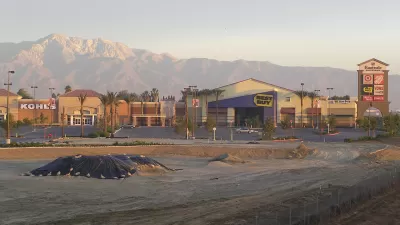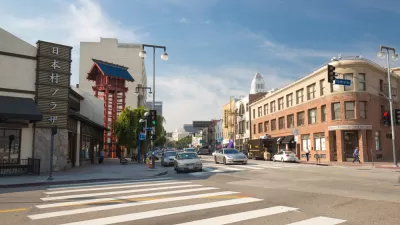The California Natural Resources Agency posted the final version of amendments to the California Environmental Quality Act, enabled by 2013's SB 743, at the end of 2018.

Melanie Curry reports on the long-awaited adoption of California's SB 743—a bill signed in 2013 to reform the California Environmental Quality Act by ending the use of Level of Service as a metric for development impact. Vehicle miles traveled is now the preferred metric. Curry refers to Level of Service as car delay, and environmentalists and smart growth advocates have long noted that it's a strange way to measure environmental impact.
"The [new] rules say that vehicle miles traveled–the amount in distance of automobile travel produced by a project–is a more appropriate measure of transportation impacts than vehicle delay," explains Curry. "Specifically, the new rule states that 'a project’s effect on automobile delay shall not constitute a significant environmental impact.' In addition, development projects within a half-mile of high quality transit are presumed not to have a significant environmental impact."
The bill that passed in 2013 might have shot higher than the final rules produced by the Governor’s Office of Planning and Research, however, after compromises during the rule making process. For instance, "planners will be allowed 'discretion' on which measure to use–so they could choose to stick with the outdated and discredited Level of Service metric," reports Curry.
"The new rules take effect immediately as advisory, but by June 2020 they will apply to all new environmental analyses," according to Curry. For more information on the final bureaucratic actions that put the new rules into advisory effect, see an article posted by Norman F. Carlin, Kevin Ashe, and Eric Moorman on the Pillsbury Law website.
FULL STORY: At Last, New Rules Are Final: Car Delay Is (Sometimes) NOT an Environmental Impact

Study: Maui’s Plan to Convert Vacation Rentals to Long-Term Housing Could Cause Nearly $1 Billion Economic Loss
The plan would reduce visitor accommodation by 25,% resulting in 1,900 jobs lost.

North Texas Transit Leaders Tout Benefits of TOD for Growing Region
At a summit focused on transit-oriented development, policymakers discussed how North Texas’ expanded light rail system can serve as a tool for economic growth.

Why Should We Subsidize Public Transportation?
Many public transit agencies face financial stress due to rising costs, declining fare revenue, and declining subsidies. Transit advocates must provide a strong business case for increasing public transit funding.

How to Make US Trains Faster
Changes to boarding platforms and a switch to electric trains could improve U.S. passenger rail service without the added cost of high-speed rail.

Columbia’s Revitalized ‘Loop’ Is a Hub for Local Entrepreneurs
A focus on small businesses is helping a commercial corridor in Columbia, Missouri thrive.

Invasive Insect Threatens Minnesota’s Ash Forests
The Emerald Ash Borer is a rapidly spreading invasive pest threatening Minnesota’s ash trees, and homeowners are encouraged to plant diverse replacement species, avoid moving ash firewood, and monitor for signs of infestation.
Urban Design for Planners 1: Software Tools
This six-course series explores essential urban design concepts using open source software and equips planners with the tools they need to participate fully in the urban design process.
Planning for Universal Design
Learn the tools for implementing Universal Design in planning regulations.
City of Santa Clarita
Ascent Environmental
Institute for Housing and Urban Development Studies (IHS)
City of Grandview
Harvard GSD Executive Education
Toledo-Lucas County Plan Commissions
Salt Lake City
NYU Wagner Graduate School of Public Service



























